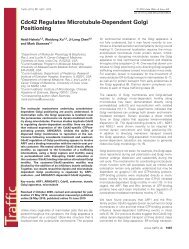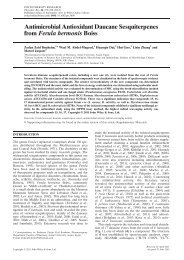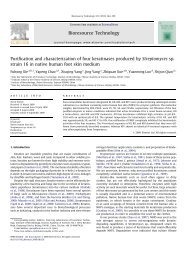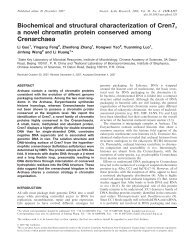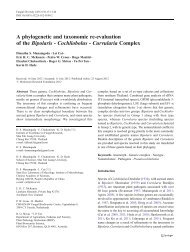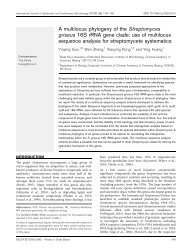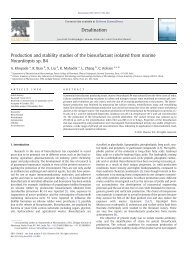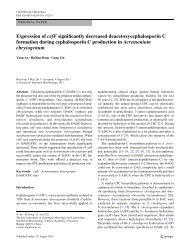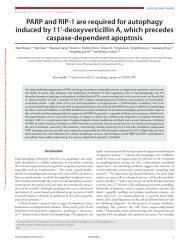Construction of an Industrial Brewing Yeast Strain to Manufacture ...
Construction of an Industrial Brewing Yeast Strain to Manufacture ...
Construction of an Industrial Brewing Yeast Strain to Manufacture ...
Create successful ePaper yourself
Turn your PDF publications into a flip-book with our unique Google optimized e-Paper software.
J. Microbiol. Biotechnol. (2010), 20(4), 767–774<br />
doi: 10.4014/jmb.0910.10013<br />
First published online 4 February 2010<br />
<strong>Construction</strong> <strong>of</strong> <strong>an</strong> <strong>Industrial</strong> <strong>Brewing</strong> <strong>Yeast</strong> <strong>Strain</strong> <strong>to</strong> M<strong>an</strong>ufacture Beer<br />
with Low Caloric Content <strong>an</strong>d Improved Flavor<br />
W<strong>an</strong>g, Jin-Jing 1,2,3 , Zhao-Yue W<strong>an</strong>g 1 *, Xi-Feng Liu 1 , Xue-Na Guo 1 , Xiu-Ping He 1 , Pierre Christi<strong>an</strong> Wensel 3 ,<br />
<strong>an</strong>d Bo-Run Zh<strong>an</strong>g 1 *<br />
1<br />
The Labora<strong>to</strong>ry <strong>of</strong> Molecular Genetics <strong>an</strong>d Breeding <strong>of</strong> <strong>Yeast</strong>s, Institute <strong>of</strong> Microbiology, Chinese Academy <strong>of</strong> Sciences, Beijing<br />
100101, P. R. China<br />
2<br />
Graduate University <strong>of</strong> Chinese Academy <strong>of</strong> Sciences, Beijing 100049, China<br />
3<br />
BBEL, Washing<strong>to</strong>n State University, Pullm<strong>an</strong>, WA 99163, U.S.A.<br />
Received: Oc<strong>to</strong>ber 12, 2009 / Revised: November 22, 2009 / Accepted: December 2, 2009<br />
In this study, the problems <strong>of</strong> high caloric content,<br />
increased maturation time, <strong>an</strong>d <strong>of</strong>f-flavors in commercial<br />
beer m<strong>an</strong>ufacture arising from residual sugar, diacetyl,<br />
<strong>an</strong>d acetaldehyde levels were addressed. A recombin<strong>an</strong>t<br />
industrial brewing yeast strain (TQ1) was generated from<br />
T1 [Lipomyces starkeyi dextr<strong>an</strong>ase gene (LSD1) introduced,<br />
α-ace<strong>to</strong>hydroxyacid synthase gene (ILV2) disrupted] by<br />
introducing Saccharomyces cerevisiae glucoamylase (SGA1)<br />
<strong>an</strong>d a strong promoter (PGK1), while disrupting the gene<br />
coding alcohol dehydrogenase (ADH2). The highest<br />
glucoamylase activity for TQ1 was 93.26 U/ml compared<br />
with host strain T1 (12.36 U/ml) <strong>an</strong>d wild-type industrial<br />
yeast strain YSF5 (10.39 U/ml), respectively. Europe<strong>an</strong><br />
Brewery Convention (EBC) tube fermentation tests<br />
comparing the fermentation broths <strong>of</strong> TQ1 with T1 <strong>an</strong>d<br />
YSF5 showed that the real extracts were reduced by<br />
15.79% <strong>an</strong>d 22.47%; the main residual mal<strong>to</strong>triose<br />
concentrations were reduced by 13.75% <strong>an</strong>d 18.82%; the<br />
caloric contents were reduced by 27.18 <strong>an</strong>d 35.39 calories per<br />
12 oz. Owing <strong>to</strong> the disruption <strong>of</strong> the ADH2 gene in TQ1, the<br />
<strong>of</strong>f-flavor acetaldehyde concentrations in the fermentation<br />
broth were 9.43% <strong>an</strong>d 13.28%, respectively, lower th<strong>an</strong><br />
that <strong>of</strong> T1 <strong>an</strong>d YSF5. No heterologous DNA sequences or<br />
drug resist<strong>an</strong>ce genes were introduced in<strong>to</strong> TQ1. Hence,<br />
the gene m<strong>an</strong>ipulations in this work properly solved the<br />
addressed problems in commercial beer m<strong>an</strong>ufacture.<br />
Keywords: <strong>Brewing</strong>, low calorie, glucoamylase, dextr<strong>an</strong>ase,<br />
yeast<br />
*Corresponding author<br />
Z.-Y.W.<br />
Phone: +86 10 64807356; Fax: +;86 10 64807427<br />
E-mail: w<strong>an</strong>gzhaoyue@126.com<br />
B.-R.Z.<br />
Phone: +86 10 64807427; Fax: +;86 10 64807427<br />
E-mail: zh<strong>an</strong>gbr@sun.im.ac.cn<br />
Beer is a beverage <strong>of</strong> immense commercial interest <strong>an</strong>d<br />
complexity. It is composed <strong>of</strong> volatile compounds, like<br />
alcohol, acetaldehyde, pent<strong>an</strong>edione, <strong>an</strong>d diacetyl, as well<br />
as nonvolatile compounds like carbohydrates [29]. Currently<br />
the consumption <strong>of</strong> alcoholic beer beverage is growing<br />
<strong>an</strong>nually worldwide [27]. However, high caloric content in<br />
beer is attributed <strong>to</strong> consumers’ health problems associated<br />
with obesity <strong>an</strong>d <strong>to</strong>oth decay [15, 19]. Both volatile <strong>an</strong>d<br />
nonvolatile components <strong>of</strong> beer contribute <strong>to</strong> its overall<br />
caloric content. Apart from alcohol, carbohydrates provide<br />
the most part <strong>of</strong> caloric content. During the brewing<br />
process, some carbohydrates remain as non-fermentable,<br />
highly caloric residual saccharides because <strong>of</strong> the absence<br />
<strong>of</strong> amylolytic activity in brewing yeast. Among these<br />
residual saccharides is mal<strong>to</strong>triose. Mal<strong>to</strong>triose, like mal<strong>to</strong>se,<br />
is the second most abund<strong>an</strong>t sugar in wort, which is<br />
normally hydrolyzed in<strong>to</strong> glucose molecules by yeast;<br />
however, this metabolite c<strong>an</strong>not be completely consumed.<br />
The slow <strong>an</strong>d incomplete consumption <strong>of</strong> mal<strong>to</strong>triose may<br />
result in beer having a high caloric content <strong>an</strong>d unusual<br />
flavor. Therefore, the reduction <strong>of</strong> excessive residual<br />
saccharides during the brewing process is a key objective.<br />
Traditionally, large amounts <strong>of</strong> exogenous enzymes (i.e.,<br />
α-amylase, dextr<strong>an</strong>ase, <strong>an</strong>d glucoamylase) [20] are added<br />
prior <strong>to</strong> fermentation <strong>to</strong> liberate fermentable sugars from<br />
polysaccharide-rich substrates. However, this has been<br />
prohibitively expensive <strong>an</strong>d responsible for consumer<br />
allergenic-related symp<strong>to</strong>ms [2, 18]. A genetically m<strong>an</strong>ipulated<br />
Saccharomyces cerevisiae fermentation strain with amylolytic<br />
properties could address these problems associated with<br />
residual saccharides. Some researchers have introduced<br />
genes encoding α-amylase, dextr<strong>an</strong>ase, or glucoamylase <strong>to</strong><br />
labora<strong>to</strong>ry yeast strains [4, 9, 13, 25]. However, labora<strong>to</strong>rygenerated<br />
recombin<strong>an</strong>t yeast strains differ markedly from<br />
industrial strains because they are m<strong>an</strong>ipulated with shuttle
768 W<strong>an</strong>g et al.<br />
vec<strong>to</strong>rs containing both <strong>an</strong>tibiotic-resist<strong>an</strong>ce <strong>an</strong>d yeastresist<strong>an</strong>ce<br />
markers deemed as a risk <strong>to</strong> beverage consumers<br />
[9, 28]. Safer industrial recombin<strong>an</strong>t strains have recently<br />
been constructed [8, 12, 14, 31, 32]. However, these strains<br />
<strong>of</strong>ten show low levels <strong>of</strong> enzyme expression <strong>an</strong>d could not<br />
improve the beer quality comprehensively since only one<br />
or two genes were modified <strong>to</strong> target-specified beer indexes.<br />
Alternatively, the complexity <strong>of</strong> beer warr<strong>an</strong>ts a more<br />
rigorous multigene regulation approach for comprehensive<br />
beer characteristic improvement.<br />
In addition <strong>to</strong> the issue <strong>of</strong> residual saccharides, other<br />
compounds such as acetaldehydes, diacetyls, <strong>an</strong>d pent<strong>an</strong>edione,<br />
which impart <strong>of</strong>f-flavors <strong>an</strong>d odors when excessive levels<br />
persist, affect the quality <strong>of</strong> beer as well. Acetaldehyde is a<br />
natural fermentation by-product <strong>an</strong>d is the direct precursor<br />
<strong>of</strong> eth<strong>an</strong>ol, <strong>an</strong>d it leaves a pungent <strong>an</strong>d irritating greenapple<br />
aroma at high concentrations but a more pleas<strong>an</strong>t<br />
fruity aroma at dilute concentrations. It also affects beer<br />
freshness [32]. The higher acetaldehyde concentration in<br />
Chinese beer (3-8 mg/l) relative <strong>to</strong> overseas fine beer<br />
(
CONSTRUCTION OF AN INDUSTRIAL BREWING YEAST STRAIN 769<br />
Table 2. Oligonucleotide primers used in the PCR amplification<br />
reactions.<br />
Primer Sequences (5' <strong>to</strong> 3')<br />
S1 TA TCTAGACCAAACGATGAGATTTCCTTC (XbaI)<br />
S2 CA GAATTC TACGTAAGCTTCAGCCTC (EcoRI)<br />
SGA1-L GTCTCTAGACTCGAGAACATTACTATAT (XbaI)<br />
SGA1-R TCCGAGCTCTACAATCCTGGCAACAAG (SacI)<br />
ADH2-L ACGAATTC GCTGTTATGTTCAAGGTC (EcoRI)<br />
ADH2-R TCGGATCC TTCAGAGGAGCAGGACAA (BamHI)<br />
PGK1-L CTTTCGACGGTATCGATAAGCT<br />
PGK1-R TTTTACATCGTCAACCTGGGCT<br />
LSD1-L GGAACGTTGTTGATTGTTTT<br />
LSD1-R TTCGACATGAACTTCCTTGGC<br />
CUP1-L CGCTATACGTGCATATGTTC<br />
ILV2-L CCCGACAATAAAGTAAATAG<br />
ILV2-R AGAAAGAAGCGTAAGATC<br />
strains were selected from the YPD plate (1.5% agar) using 9 mM<br />
copper sulfate (CuSO 4<br />
) as the selection marker.<br />
DNA M<strong>an</strong>ipulation, Plasmids <strong>Construction</strong>, <strong>an</strong>d <strong>Yeast</strong><br />
Tr<strong>an</strong>sformation<br />
Genomic DNA <strong>of</strong> yeast was prepared as described by Burke et al. [6].<br />
The ADH2 gene, the sequence <strong>of</strong> which was used for homologous<br />
recombination, was amplified from YSF5 genomic DNA using PCR<br />
with the primers ADH2-L/ADH2-R (Table 2) (Sh<strong>an</strong>ghai S<strong>an</strong>gon<br />
Biological Engineering Technology & Services Co., Ltd, Sh<strong>an</strong>ghai,<br />
China). The PCR product was subsequently subcloned in<strong>to</strong> YEp352<br />
<strong>to</strong> generate the plasmid pYA. The DNA corresponding <strong>to</strong> the SGA1<br />
gene was amplified from YSF5 genomic DNA using PCR with the<br />
primers SGA1-L/SGA1-R (Table 2). Although the glucoamylase gene<br />
already existed in the genome <strong>of</strong> YSF5 <strong>an</strong>d its derivative T1, the<br />
expression <strong>of</strong> this gene was extremely weak. The strong promoter in<br />
S. cerevisiae, the PGK1 promoter (PGK1 p<br />
) from pMP1 [8], was<br />
therefore introduced <strong>to</strong> ensure higher expression <strong>of</strong> this SGA1 gene.<br />
α Signal fac<strong>to</strong>r was employed for the purpose <strong>of</strong> secreting<br />
expression <strong>of</strong> SGA1. The fragment containing the CUP1 gene from<br />
pYCUP was introduced as a selective marker. All these fragments<br />
were then ligated in<strong>to</strong> the SacI <strong>an</strong>d SphI sites <strong>of</strong> pYA by T4 DNA<br />
ligase <strong>to</strong> generate plasmid pTQ (Fig. 1A) [22].<br />
Plasmid pTQ was digested with PvuII, <strong>an</strong>d the fragment containing<br />
the 5.0-kb expression cassette TQ (Fig. 1B) was purified using a<br />
DNA Gel Extraction Kit (Beijing Probe Bioscience Technology Co.,<br />
Ltd, Beijing, China) <strong>an</strong>d tr<strong>an</strong>sformed in<strong>to</strong> T1 using the lithium acetate<br />
(LiAc) method [23]. Since T1 has no nutritional marker, the CUP1<br />
gene that encodes a metallothionein, which binds copper, was<br />
adopted for the selection <strong>of</strong> the recombin<strong>an</strong>t strains. Recombin<strong>an</strong>t<br />
strains were selected on the YPD plate using 9 mM CuSO 4<br />
as the<br />
selection marker.<br />
Enzymes Activities Assays<br />
Alcohol dehydrogenase activity was assayed using a modified<br />
Bergmeyer method [3]. The extraction technique was modified from<br />
the original approach [24] as described by Bl<strong>an</strong>dino et al. [5].<br />
The activity <strong>of</strong> glucoamylase was measured using the DNS method<br />
[16]. One unit (U) <strong>of</strong> glucoamylase activity was defined as the amount<br />
<strong>of</strong> enzyme catalyzing the production <strong>of</strong> 1 nmole <strong>of</strong> glucose in<br />
30 min at 37 o C.<br />
Dextr<strong>an</strong>ase activity was determined from the rate <strong>of</strong> increase in<br />
reducing sugars as measured by the DNS method. One unit (U) <strong>of</strong><br />
dextr<strong>an</strong>ase was defined as the amount <strong>of</strong> enzyme required <strong>to</strong> liberate<br />
1 µmole <strong>of</strong> glucose equivalent from dextr<strong>an</strong> T-70 in 40 min at 50 o C<br />
<strong>an</strong>d pH 5.5 under the previously described conditions [21].<br />
α-Ace<strong>to</strong>lactate synthase activity was detected using the method as<br />
described by Zh<strong>an</strong>g et al. [8].<br />
Genetic Stability Test <strong>of</strong> Recombin<strong>an</strong>t <strong>Strain</strong><br />
The recombin<strong>an</strong>t strain was tr<strong>an</strong>sferred on<strong>to</strong> the YPD sl<strong>an</strong>t for 15<br />
generations. Each generation was cultivated for 36 h at 28 o C. Plate<br />
streaking <strong>of</strong> the 1st, 4th, 8th, 12th, <strong>an</strong>d 15th generation strains was<br />
performed. After 48 h <strong>of</strong> cultivation at 28 o C, 100 single-grown colonies<br />
were chosen r<strong>an</strong>domly <strong>an</strong>d tr<strong>an</strong>sferred <strong>to</strong> 0.5 ml <strong>of</strong> sterilized water<br />
<strong>an</strong>d starved for 4 h at room temperature. A Greiner inoculation loop<br />
<strong>of</strong> the starved yeast suspension was used <strong>to</strong> inoculate YPD plates<br />
containing 9 mM CuSO 4<br />
<strong>an</strong>d s<strong>to</strong>red at 28 o C for 2 days.<br />
Alcohol dehydrogenase, glucoamylase, dextr<strong>an</strong>ase, <strong>an</strong>d α-ace<strong>to</strong>lactate<br />
synthase activities <strong>of</strong> the 1st, 4th, 8th, 12th, <strong>an</strong>d 15th generation<br />
strains were <strong>an</strong>alyzed as described above.<br />
PCR Verification <strong>of</strong> Recombin<strong>an</strong>t <strong>Strain</strong><br />
PCR <strong>an</strong>alysis was performed using the primers listed in Table 2. PCR<br />
was performed in a 50-µl volume with 25 µl <strong>of</strong> Pfu or Taq mastermix<br />
(Ti<strong>an</strong>gen Biotech (Beijing) Co., Ltd, Beijing, China), 120 ng <strong>of</strong><br />
template DNA, <strong>an</strong>d 0.2 µM primers. Cycle conditions were 94 o C for<br />
5 min followed by 30 cycles <strong>of</strong> 94 o C for 30 s, 54 o C for 30 s, <strong>an</strong>d<br />
72 o C for 2 min 30 s, <strong>an</strong>d finally 72 o C for 15 min.<br />
Determination <strong>of</strong> the Number <strong>of</strong> Calories<br />
The number <strong>of</strong> calories in beer is due <strong>to</strong> the presence <strong>of</strong> alcohol <strong>an</strong>d<br />
carbohydrates. The ASBC (Americ<strong>an</strong> Society <strong>of</strong> <strong>Brewing</strong> Chemists)<br />
provides a formula for calculating the number <strong>of</strong> calories in beer<br />
[1]:<br />
Cal. per 12 oz beer=[(6.9×ABW)+4.0×(RE-0.1)]×FG×3.55. (1)<br />
The caloric contribution <strong>of</strong> eth<strong>an</strong>ol is determined from the alcoholby-weight<br />
(ABW) <strong>an</strong>d the known value <strong>of</strong> 6.9 cal/g <strong>of</strong> eth<strong>an</strong>ol. The<br />
caloric contribution from the carbohydrates present is determined<br />
from the real extract (RE) <strong>an</strong>d the known value <strong>of</strong> 4.0 cal/g for<br />
carbohydrates. An empirically derived const<strong>an</strong>t (0.1) accounts for<br />
the ash portion <strong>of</strong> the extract. These terms provide the calories per<br />
100 g <strong>of</strong> beer. This is easily converted <strong>to</strong> calories per 100 ml <strong>of</strong> beer<br />
by accounting for the final gravity [FG, in (g/ml)]. In turn, 100 ml is<br />
converted <strong>to</strong> 12 oz by a scalar value [3.55, in (ml/oz)].<br />
Preservative Qualities Assay<br />
The preservative qualities <strong>of</strong> the fermentation broths, <strong>an</strong>d the<br />
corresponding <strong>an</strong>tiaging characteristics <strong>of</strong> the various strains, were<br />
determined by measuring both the thiobarbituric acid (TBA) value<br />
<strong>an</strong>d resist<strong>an</strong>t staling value (RSV) using a spectropho<strong>to</strong>metric method<br />
[10]. These two values are two signific<strong>an</strong>t indexes reflecting beer<br />
freshness.<br />
Fermentation Test <strong>an</strong>d Pilot-Scale <strong>Brewing</strong><br />
The fermentation test was performed as described by W<strong>an</strong>g et al.<br />
[32]. The fermentation was carried out at 12 o C for 10 days first in
770 W<strong>an</strong>g et al.<br />
Fig. 1. The construction <strong>of</strong> related plasmids <strong>an</strong>d recombin<strong>an</strong>t strains.<br />
conical flasks. The yeast pellets from conical flasks were harvested<br />
for the pilot-scale brewing, which was carried out in a 6-l Europe<strong>an</strong><br />
Brewery Convention (EBC) tube with 5-l 10 °P wort at 10 o C for 15<br />
days. Real extract, attenuation degree, <strong>an</strong>d alcohol content in the<br />
fermenting filtrate were measured using <strong>an</strong> Alcolyzer Plus Beer<br />
machine WBA-505B (Kyo<strong>to</strong> Electronics M<strong>an</strong>ufacturing Co., Ltd,<br />
Tokyo, Jap<strong>an</strong>). Acetaldehydes, diacetyl, <strong>an</strong>d main residual sugars<br />
content were measured by GC/MS as described by L<strong>an</strong>daud et al.<br />
[11]. The fermentation broths were refrigerated at 4 o C for 3 days. A<br />
comparative <strong>an</strong>d qualitative test <strong>to</strong> evaluate the sensorial characteristics<br />
<strong>of</strong> the broths was then conducted on-site by six tasting experts, sent<br />
in from the division <strong>of</strong> the Tsingtao Brewery Co., per comp<strong>an</strong>y<br />
quality control procedures.<br />
RESULTS AND DISCUSSION<br />
<strong>Construction</strong> <strong>an</strong>d Selection <strong>of</strong> Recombin<strong>an</strong>t <strong>Strain</strong>s<br />
Since the higher caloric content in beer is mainly caused<br />
by the absence <strong>of</strong> amylolytic activity in brewing yeast,<br />
modification <strong>of</strong> the yeast strain by <strong>of</strong>fering amylolytic<br />
properties is a better way <strong>to</strong> solve this problem. In our<br />
previous study, the LSD1 gene was introduced in<strong>to</strong> the<br />
industrial brewing yeast YSF5 <strong>an</strong>d the engineering strain<br />
T1 was constructed. The properties <strong>of</strong> T1 have been improved;<br />
however, only LSD1 expression could not decrease the<br />
caloric content efficiently, <strong>an</strong>d therefore, <strong>an</strong>other amylolytic
CONSTRUCTION OF AN INDUSTRIAL BREWING YEAST STRAIN 771<br />
gene, SGA1, was modified in this study by enh<strong>an</strong>cing its<br />
expression with a strong promoter. In the me<strong>an</strong>time, the<br />
alcohol dehydrogenase gene (ADH2) was disrupted in<br />
order <strong>to</strong> decrease the acetaldehyde content in beer.<br />
Recombin<strong>an</strong>t strains were generated from the tr<strong>an</strong>sformation<br />
<strong>of</strong> T1 with the 5.0-kb expression cassette TQ (adh2∆::SGA1)<br />
by homologous recombination, <strong>an</strong>d 28 recombin<strong>an</strong>t strains<br />
were selected for resist<strong>an</strong>ce <strong>to</strong> higher copper concentrations<br />
(9 mM CuSO 4 ) <strong>an</strong>d sequentially named using the<br />
nomenclatures TQ1, TQ2, up <strong>to</strong> TQ28.<br />
The different enzyme activities <strong>of</strong> these 28 recombin<strong>an</strong>t<br />
strains <strong>an</strong>d T1 cultivated in YPD medium were measured.<br />
The alcohol dehydrogenase activities <strong>of</strong> the recombin<strong>an</strong>t<br />
strains were 47.01-55.78% (8.10-9.61 U/mg) lower th<strong>an</strong><br />
that <strong>of</strong> the host strain T1 (17.23 U/mg). All 28 recombin<strong>an</strong>t<br />
strains showed high glucoamylase activity, whereas<br />
insignific<strong>an</strong>t glucoamylase activity was detected in the host<br />
strain T1 (data not shown). TQ1 was chosen for further<br />
research because <strong>of</strong> its high glucoamylase activity <strong>an</strong>d low<br />
alcohol dehydrogenase activity.<br />
Genetic Stability Analysis<br />
All 100 single colonies <strong>of</strong> the 1st, 4th, 8th, 12th, <strong>an</strong>d 15th<br />
generations <strong>of</strong> the recombin<strong>an</strong>t strain TQ1 grew on the<br />
YPD plate in the presence <strong>of</strong> the selection marker, 9 mM<br />
CuSO 4 , whereas the host strains T1 <strong>an</strong>d YSF5 did not.<br />
Such long-term stable growth in copper indicated that the<br />
CUP1 gene stably integrated in<strong>to</strong> the ADH2 locus, enabling<br />
the TQ1 recombin<strong>an</strong>t strain <strong>to</strong> exhibit copper resist<strong>an</strong>ce.<br />
Likewise, evidence <strong>of</strong> long-term stability in enzymatic<br />
expression, via measured alcohol dehydrogenase, glucoamylase,<br />
<strong>an</strong>d dextr<strong>an</strong>ase activities <strong>of</strong> each generation (1st, 4th, 8th,<br />
12th, <strong>an</strong>d 15th) also indicated stable integration (data not<br />
shown).<br />
PCR Verification <strong>an</strong>d Enzymes Analysis <strong>of</strong> the<br />
Recombin<strong>an</strong>t <strong>Strain</strong><br />
The fl<strong>an</strong>king ADH2 sequences were designed for homologous<br />
recombination targeting the ADH2 allele <strong>of</strong> the T1<br />
chromosome. The SGA1 <strong>an</strong>d CUP1 genes were integrated<br />
in<strong>to</strong> the ADH2 locus <strong>of</strong> the yeast genomic DNA, which<br />
was confirmed by PCR (Fig. 2) using different primer<br />
pairs (Table 2) on the TQ1 genomic DNA. The sizes <strong>of</strong> the<br />
fragments were in agreement with the predicted PCR<br />
fragment sizes, with the exception <strong>of</strong> the PCR product<br />
using the primer pair ADH2-L/ADH2-R. This exceptional<br />
PCR product was 5.00 <strong>an</strong>d 1.70 kb in size, indicating that<br />
only one copy <strong>of</strong> ADH2 was deleted <strong>an</strong>d that <strong>an</strong> additional<br />
copy <strong>of</strong> the wild-type ADH2 was still present. Although it<br />
would have been ideal <strong>to</strong> disrupt both copies <strong>of</strong> the wildtype<br />
ADH2 gene, previous studies [30, 32] showed that<br />
one copy <strong>of</strong> the pair <strong>of</strong> ADH2 gene was more problematic<br />
<strong>to</strong> disrupt th<strong>an</strong> the other. According <strong>to</strong> our previous studies<br />
on this gene (unpublished), <strong>to</strong>tally knocking out the ADH2<br />
gene would affect the biomass <strong>of</strong> the yeast. Thus, the<br />
ADH2 gene might be essential for yeast <strong>to</strong> grow. In this<br />
work, because only one <strong>of</strong> the two copies <strong>of</strong> the ADH2<br />
gene was disrupted, alcohol dehydrogenase activity in the<br />
recombin<strong>an</strong>t strain TQ1 was still detected. However, this<br />
activity was reduced <strong>to</strong> approximately half <strong>of</strong> that<br />
observed in the T1 <strong>an</strong>d the parental YSF5 strains, which<br />
both had two intact copies <strong>of</strong> the ADH2 gene.<br />
Moreover, the sizes <strong>of</strong> the amplified PCR fragments<br />
using primers LSD1-L/LSD1-R <strong>an</strong>d ILV2-L/ILV2-R on<br />
the TQ1 template were as <strong>an</strong>ticipated. The dextr<strong>an</strong>ase <strong>an</strong>d<br />
α-ace<strong>to</strong>lactate synthase activities <strong>of</strong> strain TQ1 were similar<br />
<strong>to</strong> those <strong>of</strong> the T1 (data not shown), indicating that the<br />
disruption <strong>of</strong> ADH2 gene by SGA1 in the T1 strain did not<br />
affect the expression <strong>of</strong> dextr<strong>an</strong>ase <strong>an</strong>d α-ace<strong>to</strong>lactate<br />
Fig. 2. PCR verification <strong>of</strong> the recombin<strong>an</strong>t strains.<br />
L<strong>an</strong>e 1: Marker D15000; L<strong>an</strong>e 2: YSF5 (PGK1-L/SGA1-R); L<strong>an</strong>e 3: T1 (PGK1-L/SGA1-R); L<strong>an</strong>e 4: TQ1 (PGK1-L/SGA1-R); L<strong>an</strong>e 5: YSF5 (ADH2-L/<br />
ADH2-R); L<strong>an</strong>e 6: T1 (ADH2-L/ADH2-R); L<strong>an</strong>e 7: TQ1 (ADH2-L/ADH2-R); L<strong>an</strong>e 8: YSF5 (CUP1-L/PGK1-R); L<strong>an</strong>e 9: T1 (CUP1-L/PGK1-R); L<strong>an</strong>e<br />
10: TQ1 (CUP1-L/PGK1-R); L<strong>an</strong>e 11: YSF5 (LSD1-L/LSD1-R); L<strong>an</strong>e 12: T1 (LSD1-L/LSD1-R); L<strong>an</strong>e 13: TQ1 (LSD1-L/LSD1-R); L<strong>an</strong>e 14: YSF5<br />
(ILV2-L/ILV2-R); L<strong>an</strong>e 15: T1 (ILV2-L/ILV2-R); L<strong>an</strong>e 16: TQ1 (ILV2-L/ILV2-R); L<strong>an</strong>e 17: marker D2000.
772 W<strong>an</strong>g et al.<br />
Table 3. Glucoamylase activities <strong>of</strong> TQ1, T1, <strong>an</strong>d YSF5 in<br />
fermentation tests from conical flasks (me<strong>an</strong>±SD, n=3).<br />
Glucoamylase activity<br />
<strong>Strain</strong> Intracellular (U/mg) Fermentation broth (U/ml)<br />
YSF5 2.07±0.02 1.02±0.01<br />
T1 2.36±0.09 1.49±0.03<br />
TQ1 9.59±0.12 36.47±0.23<br />
Fig. 3. Assay <strong>of</strong> glucoamylase (A) <strong>an</strong>d dextr<strong>an</strong>ase (B) activities<br />
present in the TQ1 ( ■), T1 (○), <strong>an</strong>d YSF5 (△) yeast strains<br />
during EBC tube fermentation.<br />
Values represent the me<strong>an</strong>s <strong>of</strong> three replications.<br />
synthase. The results <strong>of</strong> the PCR reactions using the<br />
genomic DNA <strong>of</strong> YSF5 <strong>an</strong>d T1 as templates are also<br />
shown in Fig. 2, <strong>an</strong>d their amplified fragment sizes were as<br />
<strong>an</strong>ticipated. This verified that the DNA fragments were<br />
inserted in<strong>to</strong> the host strain T1’s genome.<br />
Fermentation Test <strong>an</strong>d Pilot-Scale <strong>Brewing</strong><br />
Recombin<strong>an</strong>t strain TQ1, its host strain T1, <strong>an</strong>d the<br />
parental industrial brewing yeast strain YSF5 were tested<br />
in comparative pilot-scale fermentations. The data obtained<br />
were <strong>an</strong>alyzed by a one-way <strong>an</strong>alysis <strong>of</strong> vari<strong>an</strong>ce (ANOVA).<br />
During EBC tube fermentation, different enzymes<br />
activities were detected (Fig. 3). Firstly, signific<strong>an</strong>tly<br />
higher levels <strong>of</strong> glucoamylase activity were detected in the<br />
TQ1 strain, compared with T1 <strong>an</strong>d YSF5, with the highest<br />
93.26 U/ml being observed in TQ1 fermentation broth on<br />
the 12th day <strong>of</strong> fermentation. In contrast, insignific<strong>an</strong>t<br />
glucoamylase activity was detected in both T1 <strong>an</strong>d YSF5<br />
fermentation broths through the low-level expression <strong>of</strong><br />
glucoamylase. However, under the control <strong>of</strong> the strong<br />
PGK1 promoter, the SGA1 gene was highly expressed in<br />
the recombin<strong>an</strong>t strain TQ1, <strong>an</strong>d via α signal sequence, its<br />
glucoamylase could easily be secreted in<strong>to</strong> the fermentation<br />
broth. Hence, the glucoamylase activity detected in the<br />
TQ1 fermentation broth from conical flasks exceeded that<br />
measured intracellularly by nearly 4-fold (Table 3). This<br />
value was higher th<strong>an</strong> the heterologous glucoamylase gene<br />
expression levels reported by Liu et al. [12]. Besidesthis,<br />
high levels <strong>of</strong> dextr<strong>an</strong>ase acitivity were detected in both<br />
TQ1 <strong>an</strong>d T1 fermentations, unlike in YSF5 where none<br />
was detected. This also indicated that the dextr<strong>an</strong>ase gene<br />
was steadily expressed in strain TQ1 in despite <strong>of</strong> SGA1<br />
expression <strong>an</strong>d ADH2 disruption.<br />
At the end <strong>of</strong> the EBC tube fermentation, the concentrations<br />
<strong>of</strong> certain key residual saccharides were measured. Saccharides<br />
such as glucose, sucrose, mal<strong>to</strong>se, <strong>an</strong>d fruc<strong>to</strong>se were<br />
exhausted <strong>an</strong>d not detected. The main reduction detected<br />
was the concentration <strong>of</strong> residual mal<strong>to</strong>triose using the GC/<br />
MS test (Table 4). The residual mal<strong>to</strong>triose concentration<br />
measured in the TQ1 fermentation broth (0.69 mg/l) was<br />
18.82% <strong>an</strong>d 13.75% (F=20.04, P
CONSTRUCTION OF AN INDUSTRIAL BREWING YEAST STRAIN 773<br />
-4<br />
530 Table 4. Parameters <strong>of</strong> the fermenting liquor from EBC fermentation tube (me<strong>an</strong>±SD, n=3).<br />
Parameters YSF5 T1 TQ1 F P-value<br />
%Real extract 4.54±0.02 4.18±0.03 3.52±0.06 36.55 4.36e ,S<br />
%Real attenuation 67.47±0.02 70.16±0.03 74.48±0.31 333.18 7.11e ,S<br />
Fruc<strong>to</strong>se (g/l) - - - - -<br />
Glucose (g/l) - - - - -<br />
Sucrose (g/l) - - - - -<br />
Mal<strong>to</strong>se (g/l) - - - - -<br />
Mal<strong>to</strong>triose (g/l) 0.85±0.001 0.80±0.001 0.69±0.001 20.04 1.72e ,S<br />
Acetaldehyde (ppm) 9.19±0.01 8.80±0.01 7.97±0.01 261.64 1.46e ,S<br />
Diacetyl (ppb) 147.00±4.00 134.00±1.00 130.33±10.33 45.02 2.44e ,S<br />
Pent<strong>an</strong>edione (ppb) 130.00±37.00 80.33±9.33 62.67±25.33 153.06 7.1e , S<br />
Calorie per 12 oz fermentation broth 294.86±48.53 286.65±33.44 259.47±23.39 29.31 8.01e ,S<br />
TBA value (OD ) 0.56±0.001 0.51±0.001 0.47±0.001 41.57 6.50e ,S<br />
RSV 436.58±51.70 497.39±11.98 479.54±29.99 62.58 3.58e ,S<br />
S, signific<strong>an</strong>t (P
774 W<strong>an</strong>g et al.<br />
REFERENCES<br />
1. Americ<strong>an</strong> Society <strong>of</strong> <strong>Brewing</strong> Chemists. 1992. Caloric content,<br />
Beer-33. In: Methods <strong>of</strong> Analysis <strong>of</strong> the ASBC.<br />
2. Baur, X., Z. Chen, <strong>an</strong>d I. S<strong>an</strong>der. 1994. Isolation <strong>an</strong>d denomination<br />
<strong>of</strong> <strong>an</strong> import<strong>an</strong>t allergen in baking additives: α-Amylase from<br />
Aspergillus orizae (Asp O II). Clin. Exp. Allergy 24: 1465-1470.<br />
3. Bergmeyer, H. V., K. Gacoehm, <strong>an</strong>d M. Grassl. 1974. In: Methods<br />
<strong>of</strong> Enzymatic Analysis, Vol. 2, pp. 428-429. Academic Press,<br />
NY.<br />
4. Birol, G., Z. I. Ons<strong>an</strong>, B. Kirdar, <strong>an</strong>d S. G. Oliver. 1998. Eth<strong>an</strong>ol<br />
production <strong>an</strong>d fermentation characteristics <strong>of</strong> recombin<strong>an</strong>t<br />
Saccharomyces cerevisiae strains grown on starch. Enzy. Microb.<br />
Technol. 22: 672-677.<br />
5. Bl<strong>an</strong>dino, A., I. Caro, <strong>an</strong>d D. C<strong>an</strong>tero. 1997. Comparative study<br />
<strong>of</strong> alcohol dehydrogenase activity <strong>of</strong> flor yeast extracts. Biotech.<br />
Lett. 19: 651-654.<br />
6. Burke, D., D. Dawson, <strong>an</strong>d T. Stearns. 2000. <strong>Yeast</strong> DNA<br />
isolations pp.109-111. Methods in <strong>Yeast</strong> Genetics. A Cold<br />
Spring Harbor Labora<strong>to</strong>ry Course M<strong>an</strong>ual. Cold Spring Harbor<br />
Labora<strong>to</strong>ry Press, Cold Spring Harbor, NY.<br />
7. Cai, Y., Q. Mu, Z. Y. W<strong>an</strong>g, B. R. Zh<strong>an</strong>g, <strong>an</strong>d B. J. Y<strong>an</strong>.<br />
2008. <strong>Construction</strong> <strong>of</strong> self-cloning industrial brewing yeast with<br />
high-glutathione production <strong>an</strong>d low-adhii enzyme activity.<br />
Microbiology 35: 1171-1175. (In Chinese)<br />
8. Zh<strong>an</strong>g, Y., Z. Y. W<strong>an</strong>g, X. P. He, N. Liu, <strong>an</strong>d B. R. Zh<strong>an</strong>g.<br />
2008. New industrial brewing yeast strains with ILV2 disruption<br />
<strong>an</strong>d LSD1 expression. Int. J. Food Microbiol. 123: 18-24.<br />
9. Eksteen, J. M., P. v<strong>an</strong> Rensburg, R. R. C. Otero, <strong>an</strong>d I. S.<br />
Pre<strong>to</strong>rius. 2003. Starch fermentation by recombin<strong>an</strong>t Saccharomyces<br />
cerevisiae strains expressing the α-amylase <strong>an</strong>d glucoamylase<br />
genes from Lipomyces kononenkoae <strong>an</strong>d Saccharomycopsis<br />
fibuligera. Biotech. Bioeng. 84: 639-646.<br />
10. K<strong>an</strong>eda, H. 1995. Chemical evaluation <strong>of</strong> beer flavor stability.<br />
Master Brewers Associ Am. 32: 90-94.<br />
11. L<strong>an</strong>daud, S., P. Lieben, <strong>an</strong>d D. Picque. 1998. Qu<strong>an</strong>titative<br />
<strong>an</strong>alysis <strong>of</strong> diacetyl, pent<strong>an</strong>edione <strong>an</strong>d their precursors during<br />
beer fermentation by <strong>an</strong> accurate GC/MS method. J. Inst. Brew.<br />
104: 93-99<br />
12. Liu, X. F., Z. Y. W<strong>an</strong>g, J. J. W<strong>an</strong>g, Y. Lu, X. P. He, <strong>an</strong>d B. R.<br />
Zh<strong>an</strong>g. 2009. Expression <strong>of</strong> GAI gene <strong>an</strong>d disruption <strong>of</strong> PEP4<br />
gene in <strong>an</strong> industrial brewer’s yeast strain. Lett. Appl. Microbiol.<br />
49: 117-123<br />
13. Liu, Z. R., G. Y. Zh<strong>an</strong>g, <strong>an</strong>d S. G. Liu. 2004. Constructing <strong>an</strong><br />
amylolytic brewing yeast Saccharomyces pas<strong>to</strong>ri<strong>an</strong>us suitable<br />
for accelerated brewing. J. Biosci. Bioeng. 98: 414-419.<br />
14. Liu, Z. R., G. Y. Zh<strong>an</strong>g, J. Li, <strong>an</strong>d G. H. Chen. 2008. Integrative<br />
expression <strong>of</strong> glucoamylase gene in a brewer’s yeast Saccharomyces<br />
pas<strong>to</strong>ri<strong>an</strong>us strain. Food Tech. Biotech. 46: 32-37.<br />
15. McTigue, K. M., R. Harris, <strong>an</strong>d B. Hemphill. 2003. Screening<br />
<strong>an</strong>d interventions for obesity in adults: Summary <strong>of</strong> the evidence<br />
for the U.S. Preventive Services Task Force. Ann. Int. Med.<br />
139: 933-949.<br />
16. Miller, J. L., W. E. Glennon, <strong>an</strong>d A. L. Bur<strong>to</strong>n. 1960. Measurement<br />
<strong>of</strong> carboxymethylcellulase activity. Anal. Biochem. 2: 127-132.<br />
17. Mithieux, S. M. <strong>an</strong>d A. S. Weiss. 1995. Integration <strong>of</strong> multiple<br />
ILV5 copies <strong>an</strong>d elevated tr<strong>an</strong>scription in polyploidy yeast. <strong>Yeast</strong><br />
11: 311-316.<br />
18. Nie<strong>to</strong>, A., J. A. Prie<strong>to</strong>, <strong>an</strong>d P. S<strong>an</strong>z. 1999. Stable high-copy<br />
number integration <strong>of</strong> Aspergillus oryzae α-amylase cDNA in<br />
<strong>an</strong> industrial baker’s yeast strain. Biotech. Progr. 15: 459-466.<br />
19. Nogueira, F. N., D. N. Souza, <strong>an</strong>d J. Nicolau. 2000. In vitro<br />
approach <strong>to</strong> evalutate potential harmful effects <strong>of</strong> beer on<br />
health. J. Dent. Res. 28: 271-276.<br />
20. Rom<strong>an</strong>os, M. A., C. A. Scorer, <strong>an</strong>d J. J. Clare. 1992. Foreign<br />
gene expression in yeast: A review. <strong>Yeast</strong> 278: 423-488.<br />
21. Ryu, S. J., D. Kin, <strong>an</strong>d H. J. Ryu. 2000. Purification <strong>an</strong>d partial<br />
characterization <strong>of</strong> a novel gluc<strong>an</strong>hydrolase from Lipomyces<br />
starkeyi KSM22 <strong>an</strong>d its use for inhibition <strong>of</strong> insoluble gluc<strong>an</strong><br />
formation. Biosci. Biotech. Biochem. 64: 223-228.<br />
22. Sambrook, J., E. F. Fritsch, <strong>an</strong>d T. M<strong>an</strong>iatis. 1989. Molecular<br />
Cloning: A Labora<strong>to</strong>ry M<strong>an</strong>ual. Cold Spring Harbor Labora<strong>to</strong>ry<br />
Press, Cold Spring Harbor, New York.<br />
23. Schiestl, R. H. <strong>an</strong>d R. D. Gietz. 1989. High efficiency<br />
tr<strong>an</strong>sformation <strong>of</strong> intact yeast cells using single str<strong>an</strong>ded nucleic<br />
acids as a carrier. Curr. Genet. 16: 339-346.<br />
24. Schimpfessel, L. 1968. Presence <strong>an</strong>d regulation <strong>of</strong> the synthesis<br />
<strong>of</strong> two alcohol dehydrogenase in the yeast Saccharomyces<br />
cerevisiae. Biochim. Biophys. Acta 151: 317-329.<br />
25. Shigechi, H., K. Uyama, Y. Fujita, T. Matsumo<strong>to</strong>, M. Ueda, A.<br />
T<strong>an</strong>aka, H. Fukuda, <strong>an</strong>d A. Kondo. 2002. Efficient eth<strong>an</strong>ol<br />
production from starch through development <strong>of</strong> novel flocculent<br />
yeast strains displaying glucoamylase <strong>an</strong>d co-displaying or<br />
secreting α-amylase. J. Mol. Catal. B Enzym. 17: 179-187.<br />
26. Sun, J. S., W. J. Zh<strong>an</strong>g, F. C. Jia, Y. Y<strong>an</strong>g, Z. P. Lin, J. Z. Feng,<br />
M. Pavlovic, <strong>an</strong>d D. L.W<strong>an</strong>g. 2006. Disruption <strong>of</strong> brewer’s<br />
yeast alcohol dehydrogenase II gene <strong>an</strong>d reduction <strong>of</strong> acetaldehyde<br />
content during brewery fermentation. J. Am. Soc. Brew. Chem.<br />
64: 195-201.<br />
27. Olfir, E. 2007. Volume <strong>of</strong> world beer consumption. In: The Physics<br />
Factbook TM . Accessible at: http://hypertextbook.com/facts/2001/<br />
JohnnyAlicea. shtml.<br />
28. Toshiyuki, M., U. Mitsuyoshi, Y. Midori, A. Haruyuki, S. Yumi,<br />
K. Naomi, O. Masako, A. Teruo, <strong>an</strong>d T. Atsuo. 1997. <strong>Construction</strong><br />
<strong>of</strong> a starch-utilizing yeast by cell surface engineering. Appl.<br />
Environ. Microb. 63: 1362-1366.<br />
29. Vaclavik, V. A. <strong>an</strong>d E. W. Christi<strong>an</strong>. 2007. Essentials <strong>of</strong> Food<br />
Science (Food Science Texts Series). Springer, New York.<br />
30. W<strong>an</strong>g, D. L., X. L. Song, <strong>an</strong>d W. J. Zh<strong>an</strong>g. 2005. Study on the<br />
decrease <strong>of</strong> acetaldehyde in beer by molecular biological technique.<br />
Beer Sci. Technol. 12: 18-23. (In Chinese)<br />
31. W<strong>an</strong>g, Z. Y., X. P. He, N. Liu, <strong>an</strong>d B. R. Zh<strong>an</strong>g. 2008.<br />
<strong>Construction</strong> <strong>of</strong> self-cloning industrial brewing yeast with highglutathione<br />
<strong>an</strong>d low-diacetyl production. Int. J. Food Sci. Technol.<br />
43: 989-994.<br />
32. W<strong>an</strong>g, Z. Y., J. J. W<strong>an</strong>g, X. F. Liu, X. P. He, <strong>an</strong>d B. R. Zh<strong>an</strong>g.<br />
2009. Recombin<strong>an</strong>t industrial brewing yeast strains with ADH2<br />
interruption using self-cloning GSH1+CUP1 cassette. FEMS<br />
<strong>Yeast</strong> Res. 9: 574-581.<br />
33. Zhao, L. J., D. L. W<strong>an</strong>g, Y. L. Cheng, J. Z. Zhou, <strong>an</strong>d B. G. Ge.<br />
2006. Study on the control <strong>of</strong> aldehyde content in beer by<br />
molecular biological measures. Liquor-Making Sci. Technol.<br />
1: 45-47. (In Chinese)





